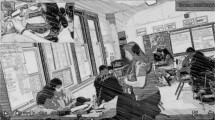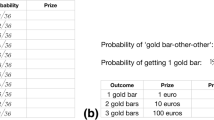Abstract
Over the last three decades, educational researchers and policymakers have increasingly promoted instructional strategies that centralize group work in mathematics. One difficulty teachers face in implementing group-based instruction in mathematics involves facilitating meaningful group interaction amongst students. In this paper, we explore student noticing as a novel strategy for supporting college students to collaborate effectively during group work in mathematics. First, we construct a noticing framework named student noticing of collaborative practices which provides a lens for “seeing” how students notice their collaborative practices. Then, we use the framework to explore how 25 college students noticed their collaborative practices in mathematics. After working on a novel mathematics task in groups, the college students listened to audiorecordings of their group interactions and responded to reflection questions about the effectiveness of their collaboration. We identified themes regarding how and what students noticed related to their collaborative practices. The findings reveal that students attended to many aspects of their collaboration, including their talking turns and propensity to listen to others. Students demonstrated a desire to change their collaborative practices in the future. The findings imply that teachers and researchers might leverage student noticing as a tool for improvement in mathematics group-based classrooms.



Similar content being viewed by others
Data availability
The dataset analyzed during the current study are not publicly available due to continued analysis and privacy of participants but are available from the corresponding author on reasonable request.
Notes
Although König et al.’s (2022) research refers to teacher noticing, these perspectives map nicely onto student noticing as well.
We do not exemplify the chain through “being recorded” because this chain is unlikely to be present in group collaboration when audio recorders are not used.
References
Barron, B. (2003). When smart groups fail. The Journal of the Learning Sciences, 12(3), 307–359.
Bishop, J. P. (2012). “She’s always been the smart one. I’ve always been the dumb one”: Identities in the mathematics classroom. Journal for Research in Mathematics Education, 43(1), 34–74.
Boaler, J. (1998). Open and closed mathematics: Student experiences and understandings. Journal for Research in Mathematics Education, 29, 41–62.
Boaler, J. (2000). Exploring situated insights into research and learning. Journal for Research in Mathematics Education, 31(1), 113–119.
Boaler, J. (2006). How a detracked mathematics approach promoted respect, responsibility, and high achievement. Theory Into Practice, 45(1), 40–46.
Boaler, J. (2008). Promoting ‘relational equity’ and high mathematics achievement through an innovative mixed-ability approach. British Educational Research Journal, 34(2), 167–194.
Boaler, J., & Staples, M. (2008). Creating mathematical futures through an equitable teaching approach: The case of Railside School. Teachers College Record, 110(3), 608–645.
Boaler, J. (2022). Mathematical mindsets: Unleashing students’ potential through creative mathematics, inspiring messages and innovative teaching (2nd ed.). Jossey-Bass.
Campbell, T. G. (2021). Examining how middle grade mathematics students develop learning opportunities through conflict in small groups. Mathematical Thinking and Learning. Advanced online publication. https://doi.org/10.1080/10986065.2021.1949529
Campbell, T. G., & Yeo, S. (2022). Professional noticing of coordinated mathematical thinking. British Educational Research Journal, 48(3), 488–503.
Campbell, T. G., et al. (2022). Supporting college students to communicate productively in groups: A self-awareness intervention. International Journal of Educational Research Open, 3, 100213.
Campbell, T. G., Yeo, S. (2023). Exploring in-the-moment teaching moves that support sociomathematical and general social norms in dialogic instruction. International Journal of Science and Mathematics Education, 21(1),1–23.
Chan, M. C. E., et al. (2018). The social essentials of learning: An experimental investigation of collaborative problem solving and knowledge construction in mathematics classrooms in Australia and China. Mathematics Education Research Journal, 30(1), 39–50.
Clark, R. E., et al. (2012). Putting students on the path to learning: The case for fully guided instruction. American Educator, 36(1), 6–11.
Cohen, E. G. (1994). Restructuring the classroom: Conditions for productive small groups. Review of Educational Research, 64(1), 1–35.
Dillenbourg, P., & Fischer, F. (2007). Computer-supported collaborative learning: The basics. Zeitschrift Für Berufs-Und Wirtschaftspädagogik, 21, 111–130.
Franke, M. L., et al. (2007). Mathematics teaching and classroom practice. In F. K. Lester (Ed.), Second Handbook of Research on Mathematics Teaching and Learning (pp. 225–256). Information Age Publishing.
Gillies, R. M. (2019). Promoting academically productive student dialogue during collaborative learning. International Journal of Educational Research, 97, 200–209.
Goodwin, A. L. (1994). Making the transition from self to other: What do preservice teachers really think about multicultural education? Journal of Teacher Education, 45(2), 119–131.
Heyd-Metzuyanim, E. (2015). Vicious cycles of identifying and mathematizing: A case study of the development of mathematical failure. Journal of the Learning Sciences, 24(4), 504–549.
Hofmann, R., & Mercer, N. (2016). Teacher interventions in small group work in secondary mathematics and science lessons. Language and Education, 30(5), 400–416.
Hofmann, R., & Ruthven, K. (2018). Operational, interpersonal, discussional and ideational dimensions of classroom norms for dialogic practice in school mathematics. British Educational Research Journal, 44(3), 496–514.
Hohensee, C. (2016). Student noticing in classroom settings: A process underlying influences on prior ways of reasoning. The Journal of Mathematical Behavior, 42, 69–91.
Jacobs, V. R., et al. (2010). Professional noticing of children’s mathematical thinking. Journal for Research in Mathematics Education, 41(2), 169–202.
Johnson, D. W., & Johnson, R. (2016). Cooperative learning and teaching citizenship in democracies. International Journal of Educational Research, 76, 162–177.
Johnson, D. W., et al. (2010). Cooperative learning in middle schools: Interrelationship of relationships and achievement. Middle Grades Research Journal, 5(1), 1–18.
Johnson, D. W., et al. (2000). Cooperative learning methods: A meta-analysis. University of Minnesota.
König, J., et al. (2022). Teacher noticing: A systematic literature review of conceptualizations, research designs, and findings on learning to notice. Educational Research Review, 100453.
Kotsopoulos, D. (2010). When collaborative is not collaborative: Supporting student learning through self-surveillance. International Journal of Educational Research, 49(4–5), 129–140.
Liljedahl, P. (2016). Building thinking classrooms: Conditions for problem solving. In P. Felmer, J. Kilpatrick, & E. Pekhonen (Eds.), Posing and Solving Mathematical Problems: Advances and New Perspectives (pp. 361–386). Springer.
Lobato, J., et al. (2012). “Noticing” as an alternative transfer of learning process. Journal of the Learning Sciences, 21(3), 433–482.
Lobato, J., Hohensee, C., & Rhodehamel, B. (2013). Students’ mathematical noticing. Journal for Research in Mathematics Education, 44(5), 809–850.
Mason, J. (2011). Noticing: Roots and branches. In M. G. Sherin, V. Jacobs, & R. Philipp (Eds.), Mathematics teacher noticing (pp. 35–50). Routledge.
Mason, J. (2002). Researching your own practice: the discipline of noticing. Routledge.
Munter, C., et al. (2015). Dialogic and direct instruction: Two distinct models of mathematics instruction and the debate(s) surrounding them. Teachers College Record, 117(11), 1–32.
Murphy, P. K., et al. (2018). Quality Talk: Developing students’ discourse to promote high-level comprehension. American Educational Research Journal, 55(5), 1113–1160.
Murphy, C., et al. (2021). Teachers and students’ views prior to introducing inquiry-based learning in Qatari science and mathematics classrooms. Teaching and Teacher Education, 104, 103367.
Nowell, L. S., et al. (2017). Thematic analysis: Striving to meet the trustworthiness criteria. International Journal of Qualitative Methods, 16(1), 1609406917733847.
Palincsar, A., et al. (1988). Collaborating in the intrest of collaborative learning. Paper presented at the Annual Meeting of the American Educational Research Association, New Orleans.
Sfard, A., & Kieran, C. (2001). Cognition as communication: Rethinking learning-by-talking through multi-faceted analysis of students’ mathematical interactions. Mind, Culture, and Activity, 8(1), 42–76.
Shaughnessy, M., Garcia, N. M., O’Neill, M. K., Selling, S. K., Willis, A. T., Wilkes, C. E., Salazar, S. B., & Ball, D. L. (2021). Formatively assessing prospective teachers’ skills in leading mathematics discussions. Educational Studies in Mathematics, 108(3), 451–472.
Sherin, M. G., & Han, S. Y. (2004). Teacher learning in the context of a video club. Teaching and Teacher Education, 20(2), 163–183.
Sherin, M. G., & Russ, R. S. (2014). Teacher noticing via video: The role of interpretive frames. In B. Calandra & P. Rich (Eds.), Digital video for teacher education: Research and practice (pp. 3–20). Taylor and Francis.
Sherin, B., & Star, J. R. (2010). Reflections on the study of teacher noticing. In M. G. Sherin, V. R. Jacobs, & R. A. Philipp (Eds.), Mathematics teacher noticing: Seeing through teachers’ eyes (pp. 66–78). Routledge.
Sherin, M., & van Es, E. (2005). Using video to support teachers’ ability to notice classroom interactions. Journal of Technology and Teacher Education, 13(3), 475–491.
Slavin, R. E., et al. (2003). Cooperative learning and achievement: Theory and research. In W. M. Reynolds, G. E. Miller, & I. B. Weiner (Eds.), Handbook of psychology: Educational psychology (pp. 179–198). John Wiley & Sons Inc.
Smith, M., & Stein, M. K. (2011). Five practices for orchestrating productive mathematical discourse. National Council of Teachers of Mathematics.
van Es, E. A., & Sherin, M. G. (2008). Mathematics teachers’ “learning to notice” in the context of a video club. Teaching and Teacher Education, 24(2), 244–276.
van Es, E. A., et al. (2022). Multidimensional noticing for equity: Theorizing mathematics teachers’ systems of noticing to disrupt inequities. Journal for Research in Mathematics Education, 53(2), 114–132.
Walkoe, J. (2015). Exploring teacher noticing of student algebraic thinking in a video club. Journal of Mathematics Teacher Education, 18(6), 523–550.
Webb, N. M. (2009). The teacher’s role in promoting collaborative dialogue in the classroom. British Journal of Educational Psychology, 79(1), 1–28.
Wieman, R., & Webel, C. (2019). Patterns linking interpreting and deciding how to respond during the launch of a lesson: Noticing from an integrated perspective. Mathematics Teacher Education and Development, 21(1), 28–50.
Wilkie, K. J. (2022). Generalization of quadratic figural patterns: Shifts in student noticing. The Journal of Mathematical Behavior, 65, 100917.
Wood, M. B. (2013). Mathematical micro-identities: Moment-to-moment positioning and learning in a fourth-grade classroom. Journal for Research in Mathematics Education, 44(5), 775–808.
Yackel, E., & Cobb, P. (1996). Sociomathematical norms, argumentation, and autonomy in mathematics. Journal for Research in Mathematics Education, 27(4), 458–477.
Author information
Authors and Affiliations
Corresponding author
Ethics declarations
Conflict of interest
The authors declare no competing interests.
Additional information
Publisher's note
Springer Nature remains neutral with regard to jurisdictional claims in published maps and institutional affiliations.
Rights and permissions
Springer Nature or its licensor (e.g. a society or other partner) holds exclusive rights to this article under a publishing agreement with the author(s) or other rightsholder(s); author self-archiving of the accepted manuscript version of this article is solely governed by the terms of such publishing agreement and applicable law.
About this article
Cite this article
Campbell, T.G., Yeo, S. Student noticing of collaborative practices: exploring how college students notice during small group interactions in math. Educ Stud Math 113, 405–423 (2023). https://doi.org/10.1007/s10649-023-10206-3
Accepted:
Published:
Issue Date:
DOI: https://doi.org/10.1007/s10649-023-10206-3




